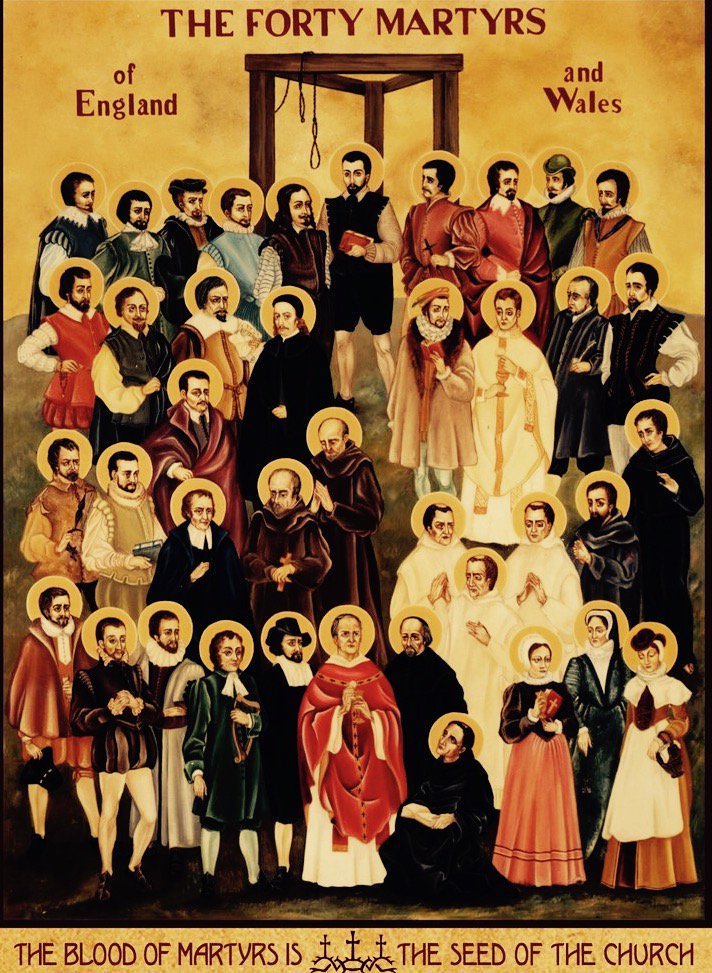Last week on October 25th it was the commemoration of the 40 martyrs English & Welsh Martyrs who are nevertheless just a small fraction of the martyrs of the Reformation. In this day as we read of these heroes of the Church in this posting by Fr. Daniel Vitz, a priest in the Institute of the Incarnate Word, IVE, let us think also of all the unnamed, unknown heroes who have also laid down their lives for the Faith.
Fr Daniel writes:
May 3rd is the anniversary of the death of Henry Garnet, who was the superior of the Jesuit mission in England during the reign of Queen Elizabeth and then King James. Falsely accused of treason in the wake of the Gunpowder Plot, he was martyred for refusing to break the seal of the confessional. Two days later—May 5th—is the feast day of St. Margaret Clitherow, a laywoman and mother who was likewise martyred, in her case for helping a priest; simply feeding him and allowing him to stay in her home. Right between those two dates, May 4th, is the feast day of the Martyrs of England and Wales. Those 284 martyrs—themselves only a fraction of those who were killed for the faith in the UK—were priests, religious brothers, laymen and women who died the most gruesome deaths imaginable in order to help preserve the Catholic faith in the United Kingdom—the faith that Gregory the Great first planted when he sent Augustine of Canterbury to convert England—in order to make the “Angles” to be “angels.”
We know that the Catholic Church is the one, true church, established by Christ and built on the foundation of the apostles. And so we must never forget all those faithful members of the Church who—like the Apostles—have given their lives for the Church. We are privileged, incredibly blessed to be members of the Catholic Church, but we are standing on the shoulders of giants. Giants of virtue, of honor, of sacrifice, of unimaginable courage; in a word, giants of sanctity.
St. Nicholas Owen, one of those 40 martyrs of England and Wales, was a religious brother who built secret hiding places in Catholic houses—‘priest holes,’ they were called. The English authorities wanted to know where he had built these hiding places, and over days they tortured him until his abdomen ruptured and his bowels literally fell out onto the floor; but they never got the information from him that they wanted. Or St. Alexander Briant. A priest, Briant was a big, physically strong man, who they tortured over and over again—and who fasted while imprisoned for the conversion his torturers. His jailers didn’t convert, though, (or at least not fast enough) and when they were done with him, just like all those other priest martyrs, he was hung, drawn, and quartered—they hung him by the neck, but before he was dead, they cut him down (still conscious) and cut off his private parts with a butcher knife. Then they cut open his stomach, while he was still alive, and slowly fed his insides into a pot of boiling oil; then when he finally died, they cut off his head, and cut his body into four parts and stuck them on pikes over the city gates, as a warning to other Catholics. He was 25 years old when he died, and had been a priest for 3 years.

St. John Rigby, a layman, died the same death; he kissed the scaffold and gave a gold coin to his executioner to thank him for making him a martyr. And consider Nicholas Postgate, a man who spent his entire priesthood—over 50 years!—on the lam, always in disguise, hiding out in this house or that barn so that he wouldn’t be caught. But eventually he was, and he too was martyred—hung, drawn, and quartered—when he was 82 years old.
One could go on and on about just this one persecution in this one country at this one time—but it’s not necessary. The point is that we are Christians, yes, and we have this incredible inheritance that comes directly from Jesus Christ himself. But we have more even than that; we are part of the legacy of heroes; the most fearless and valiant, the most noble lineage imaginable. If anyone wants to stand for something, knowing that he is in the very best company, then there is simply no place better to stand than in the Catholic Church—not just in good times, but most especially in bad times. None of us knows exactly what the future holds in store for ourselves or our country or our world or our faith. But there is one thing we do know—that the Catholic Church will endure, and that there will be more heroes, more saints, more martyrs as the Church Militant battles on. Let us pray to Our Lady, Mother of the Church, that if and when the time comes, we too will be prepared to embrace the cross, the scaffold, the gibbet, the guillotine, the gas chamber, or whatever other terrible death may confront those who hold true to the Catholic Faith.
Below: an All Saints icon – the cloud of witnesses.

